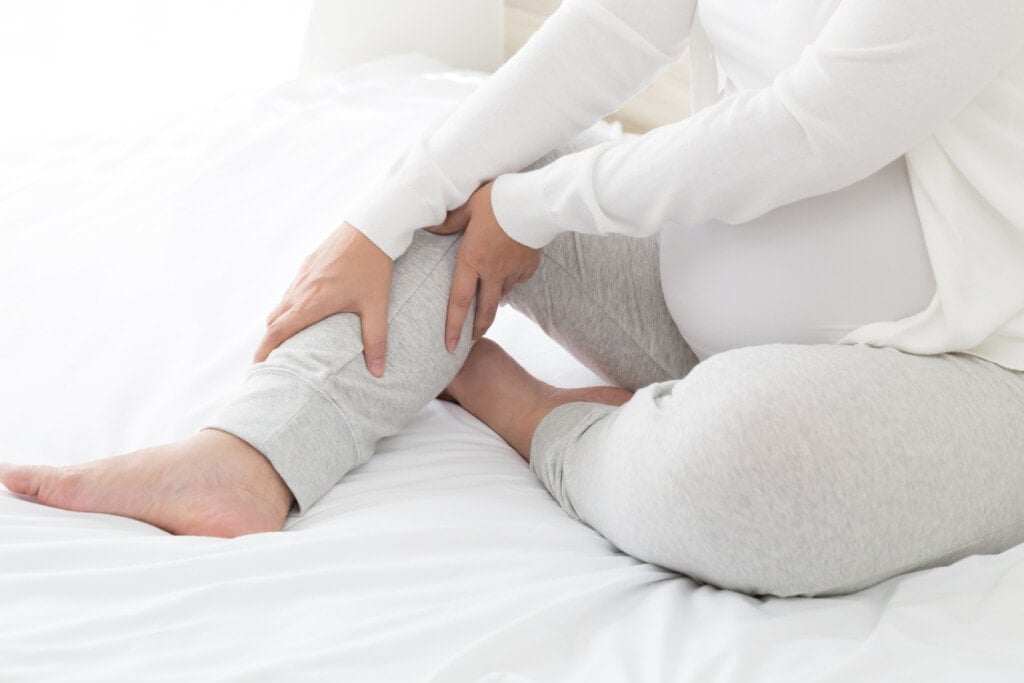When I was pregnant with my first daughter and curious about what labor would feel like, a friend compared labor contractions to a leg cramp or charley horse. I knew what she was talking about because I had been getting leg cramps during pregnancy nearly every night in my third trimester. One of my calves would tighten, cramp, reach a peak, and slowly subside. After having now experienced labor, I would agree with the comparison. Maybe women get leg cramps during pregnancy to help us prepare and cope with the pain of labor!
In all seriousness, there are many theories on why women get leg cramps during pregnancy. While common and harmless, they can be disruptive, annoying, and painful. If you are experiencing leg cramps during pregnancy, you may be wondering why it is happening and what you can do about it.
What Is a Leg Cramp?
A leg cramp is a sudden, painful contraction or tightening of a skeletal muscle that happens without you intentionally trying to tighten or move it. During the cramp, the muscle may feel like it is bulging or very hard to the touch.1
Typically leg cramps happen in the calves, but they can also occur in the hamstrings or quadriceps of the thighs. Most often, these leg cramps of pregnancy occur at night.1,2
While leg cramps during pregnancy are typically non-threatening, they are painful and inconvenient. Poor sleep can affect your quality of life and may contribute to more prolonged labor and a higher risk of C-section.3
How Common Are Leg Cramps During Pregnancy?
Somewhere between 30 and 50 percent of women report experiencing leg cramps during pregnancy. They are more common in the second and third trimesters.2,4
What Causes Leg Cramps During Pregnancy?
Pregnancy causes many changes in the body that can put additional demands on your body and contribute to the causes of leg cramps. Some contributing factors for leg cramps during pregnancy include:
Overuse
Carrying around the extra weight of pregnancy can increase the strain on your leg muscles and cause cramping at night. Also, if you do strenuous exercise during pregnancy, particularly without stretching before and after, your leg muscles can cramp from overuse.2
Dehydration
Your fluid demands increase when pregnant to maintain your blood volume, build the placenta, and fill the amniotic sac with fluid. If you are not keeping up with your water needs, this may dehydrate you and contribute to leg cramps during pregnancy.5
Pressure From the Baby
Your growing baby and uterus can pressure blood vessels and nerves that lead to your legs. This can cause leg cramps in pregnancy, mainly because nerves typically cause leg cramps, not the muscle itself.4,6
Low Magnesium
Magnesium plays an essential role in muscle function. Compared to non-pregnant women, pregnant women are often magnesium deficient, which is thought to be why pregnancy seems to cause leg cramps.4
How to Prevent Leg Cramps During Pregnancy
You may prevent future leg cramps during pregnancy by addressing the cause. To reduce the chance of experiencing leg cramps, you can try the following:
Stretching
Stretching before and after exercise and other times throughout the day can help prevent leg cramps during pregnancy. Any position that brings your toes toward your shin will help to stretch the calf muscle. This may help relieve nerve or blood vessel compression traveling to your legs, contributing to leg cramps.6
Compression Socks
Wearing compression socks throughout the day and while you sleep can help maintain adequate blood flow in your legs, which may prevent leg cramps.6
Hydration
Since dehydration can contribute to leg cramps, ensure you drink enough water throughout the day. Your water intake requirements may have increased from pre-pregnancy. The American Pregnancy Association recommends drinking at least eight to 12 cups of water daily while pregnant.5
Diet and Supplementation
Ensure you are consuming enough magnesium, calcium, and potassium during pregnancy, as these minerals play an important role in hydration and muscle function. Fruits, vegetables, beans, and dairy are excellent sources of these nutrients.1,6,7
If you cannot get enough of these nutrients through diet alone, talk to your provider before introducing supplements into your regimen. They may have side effects or interact with other medications you may be taking.
Treatment of Leg Cramps During Pregnancy
Leg cramps can be excruciating, but fortunately, their duration is typically short. Sometimes the best thing you can do is ride out the pain, but if the cramp lasts for a more extended period, there are some things you can try to relieve it.2,6
Stretching
Just as stretching can help to prevent leg cramps, it can also help to relieve them. As soon as you feel a cramp coming on, try to flex your leg. This might help prevent the cramp from reaching a peak, reducing the severity and duration of the pain.
Massage
If the cramp in your leg persists, gently massage the muscle to get it to release or ask someone to assist you.
Heat
Heat encourages muscles to loosen and promotes relaxation. If your leg cramp does not subside, apply a warm compress or take a warm bath.
When to Contact Your Doctor
If you are experiencing a leg cramp that will not go away or notice redness or swelling in your legs along with your leg cramps, this could indicate a blood clot. Contact your provider immediately for an evaluation to rule out something more serious.2
Even if you are not suspicious that your leg cramps are anything significant, they are worth mentioning at your next prenatal visit. Your doctor may be able to make recommendations or check your blood for vitamin and mineral deficiencies contributing to your symptoms.
Between constantly having to pee in the middle of the night and finding it impossible to find a comfortable sleeping position, the last thing a pregnant woman needs is one more thing making it difficult to sleep! Unfortunately, leg cramps often strike at night, waking you up and further disturbing your sleep. Although they are typically not indicative of anything more serious, they are frustrating. Knowing what they are, why they happen, and how to prevent and treat them can help you avoid them or at least be prepared when they strike.





























